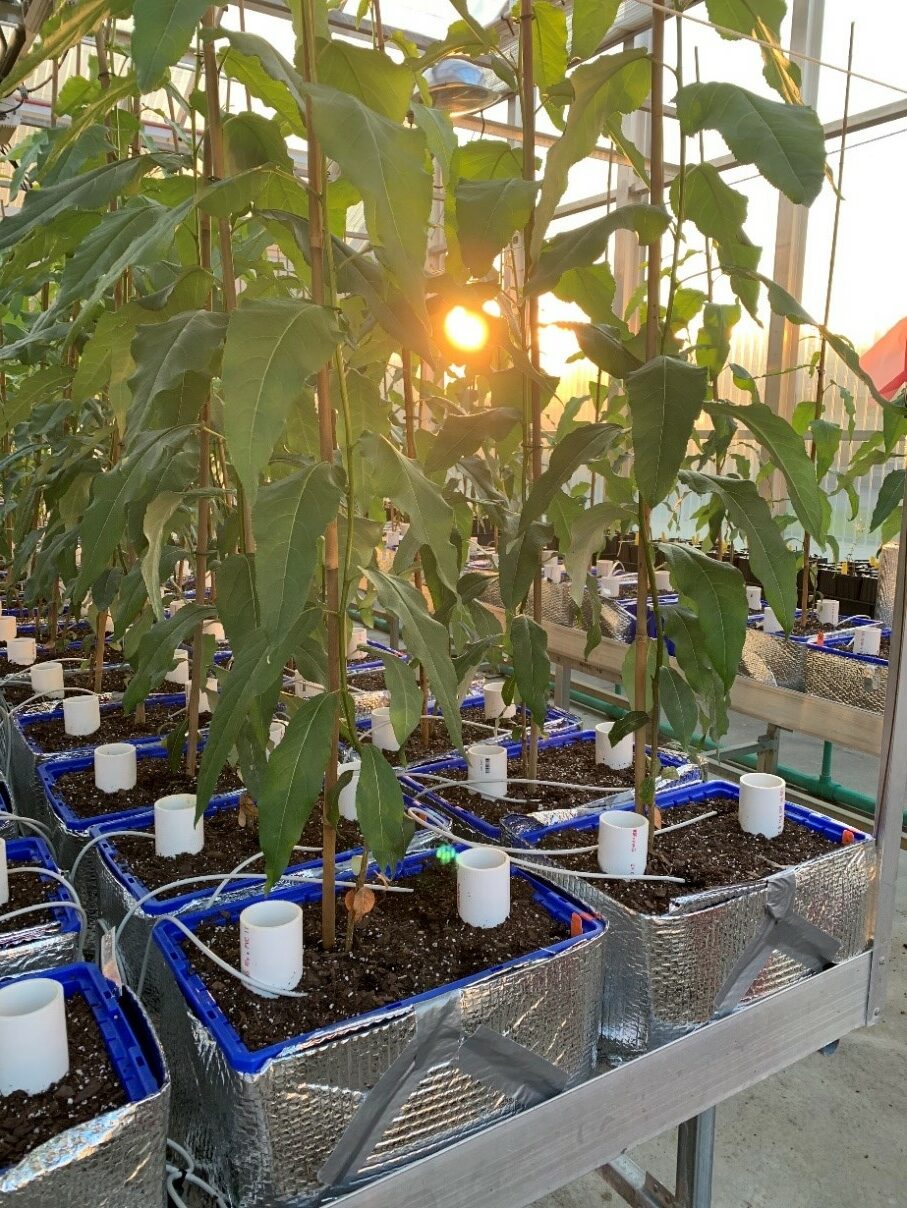August 19, 2021
Poplar Trees Have Physiological Limits to Warming
Black cottonwood saplings displayed positive acclimation to 4 °C of warming but showed excessive stress at 8 °C

Poplar clones established for subsequent warming treatments. Soil respiration was measured from white collars above root and root-free compartments.
[Courtesy Oak Ridge National Laboratory.]
The Science
Researchers examined the effects of warming conditions on young Populus trichocarpa trees. They used climate-controlled growth chambers and measured carbon uptake (as photosynthesis) and carbon loss (as respiration) from leaves, roots, and soil. Findings show that photosynthetic rates increased with temperature at monthly time scales, but that warming also increased leaf, root, and soil respiration. Total plant growth was greatest at intermediate levels of warming (+4 °C) as compared with un-warmed control (+0 °C) or severely warmed (+8 °C) trees. Root respiration rates were dependent on root nitrogen content in the warmest treatment, indicating the importance of plant-soil interactions and their role in plant adjustment to climate change.
The Impact
Earth’s climate continues to warm, which has direct effects on plant physiology and resultant growth rates of forests and biomass plantations. Understanding the physiological limits of thermal acclimation of important forest species and their interaction with other environmental conditions is necessary to understand terrestrial carbon uptake and potential climate feedbacks due to changes in productivity. Environmental warming occurs concurrently with periodic changes in other stressors, like pathogens or drought. Thus, although these results point to the ability of poplar trees to acclimate to and benefit from future temperature conditions, there may be other mitigating controls on ecosystem productivity.
Summary
Plant metabolic acclimation to thermal stress remains underrepresented in current global climate models. Gaps exist in our understanding of how key metabolic processes (i.e., photosynthesis, respiration) adjust and acclimate over time and how aboveground versus belowground acclimation differs. Researchers compared aboveground vs. belowground physiological responses to warming over time for ninety genetically identical ramets of Populus trichocarpa. After establishment at 25°C for six weeks, sixty clones were warmed to either +4°C or +8°C and monitored for ten weeks, measuring photosynthesis and respiration from the leaves, roots, and soil. Results showed thermal acclimation (beneficial adjustment to the new temperature) in both photosynthesis and respiration, with rates initially increasing, then declining as the optimal temperature for photosynthesis and the temperature-sensitivity (i.e., Q10) of respiration adjusted to warmer conditions.
In addition to a higher optimal temperature for photosynthesis, the maximum rates of photosynthesis were also higher. Belowground, soil respiration decreased with warming, while root-free soil respiration declined abruptly, then remained constant with additional warming. Plant biomass was greatest at +4°C, with 30% of structural carbon allocated belowground. Rates of root respiration were similar among treatments, however, root nitrogen increased at +8°C leading to lower rates of root respiration per unit of nitrogen. The exponential (Q10) temperature relationship of Rr was affected by warming, leading to differing values among treatments. By measuring carbon uptake and carbon losses from each treatment, these results suggest that moderate climate warming (+4°C) may lead to optimized plant adjustments to temperature and increased plant growth, but those increases could be limited with severe warming (+8°C).
Principal Investigator
Jeff Warren
Oak Ridge National Laboratory
warrenjm@ornl.gov
Program Manager
Daniel Stover
U.S. Department of Energy, Biological and Environmental Research (SC-33)
Environmental System Science
daniel.stover@science.doe.gov
Funding
This research was supported by the Environmental Systems Science (ESS) program of the Office of Biological and Environmental Research (BER), within the U.S. Department of Energy’s (DOE) Office of Science. This research was also supported by a graduate research fellowship awarded to J. Aaron Hogan (Ph.D. student, FIU) by DOE’s Office of Science Graduate Student Research (SCGSR) program.
References
Hogan, J.A., et al.. "The Physiological Acclimation and Growth Response of Populus trichocarpa to Warming." Physiologia Plantarum 173 (3), 1008–1029 (2021). https://doi.org/10.1111/ppl.13498.

